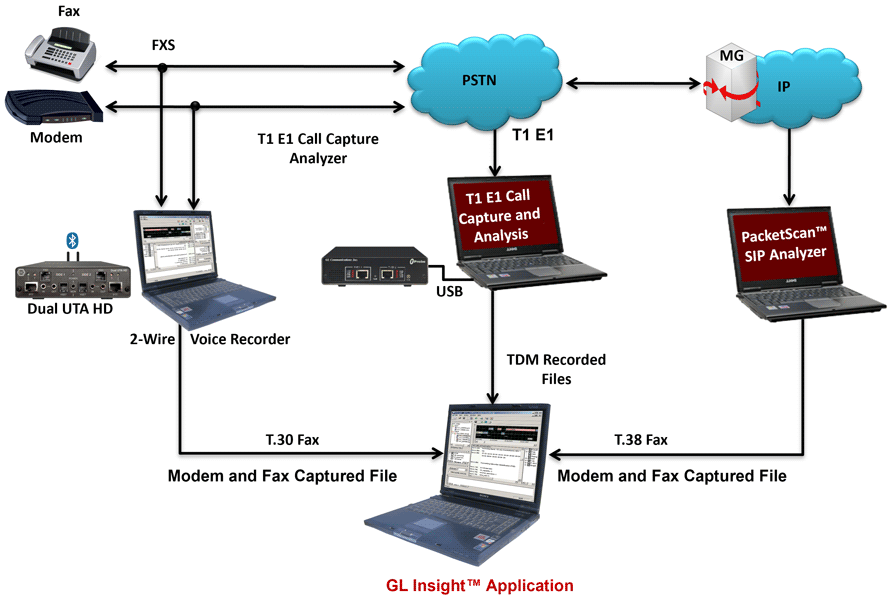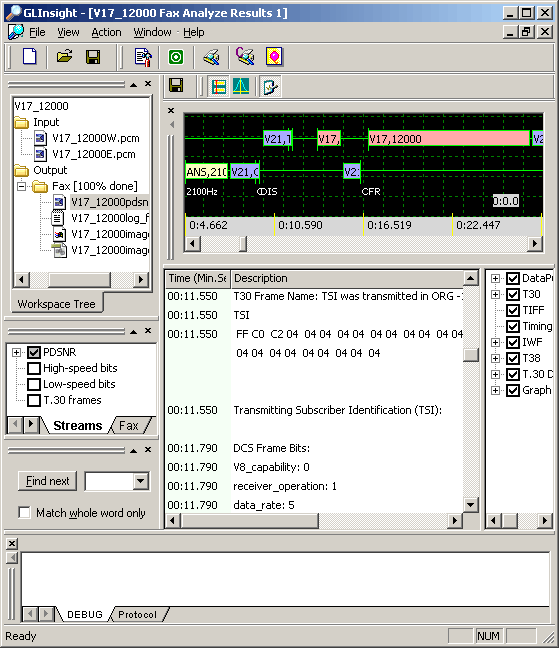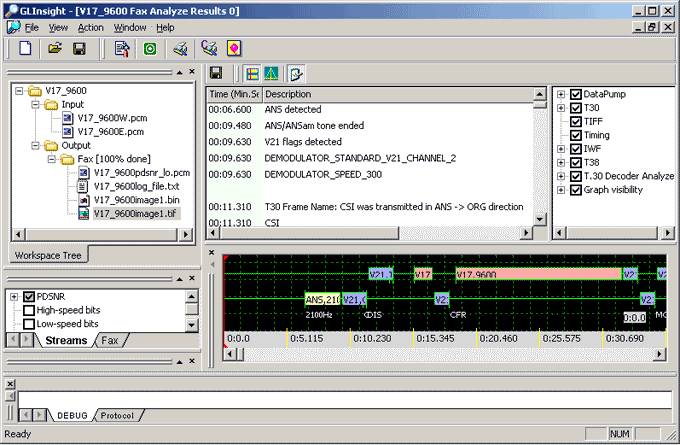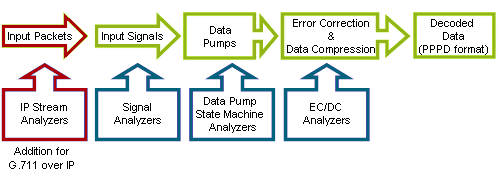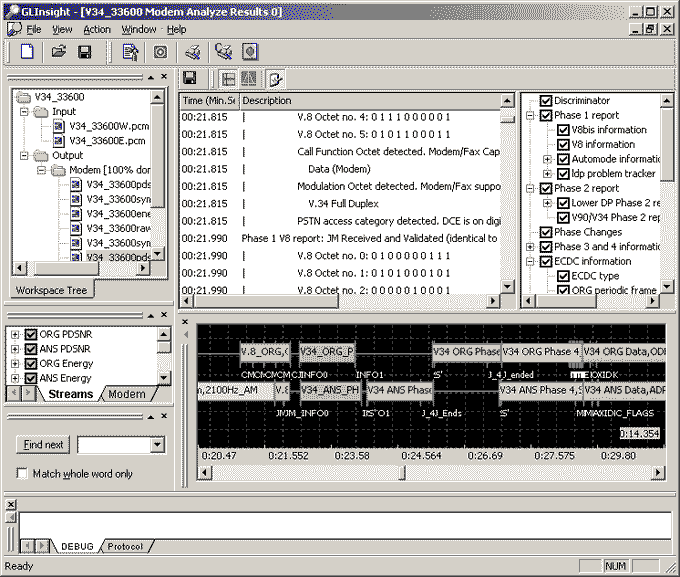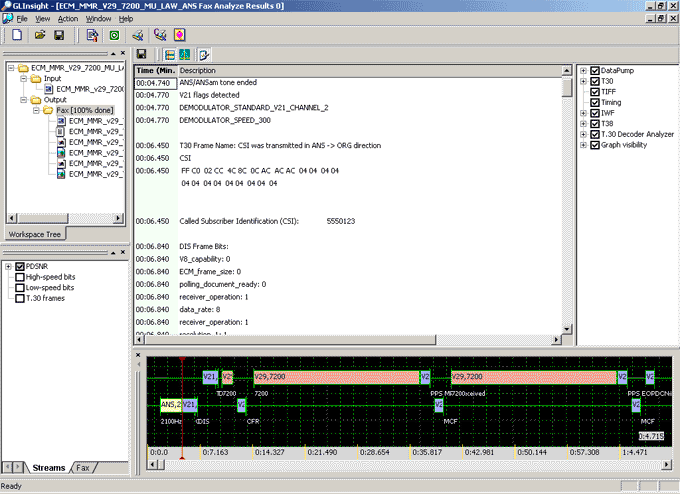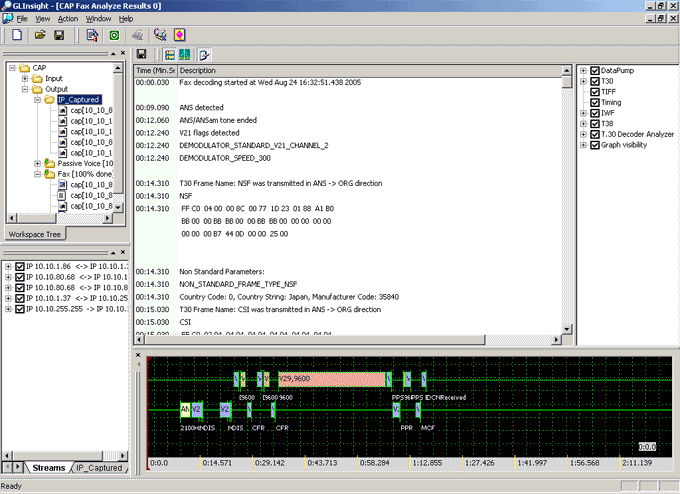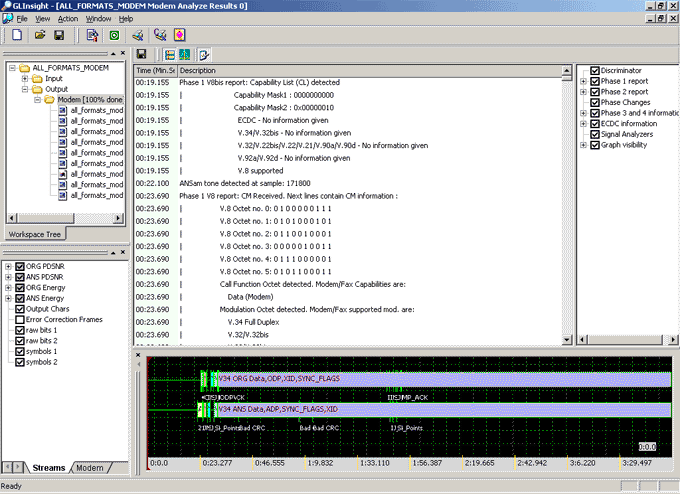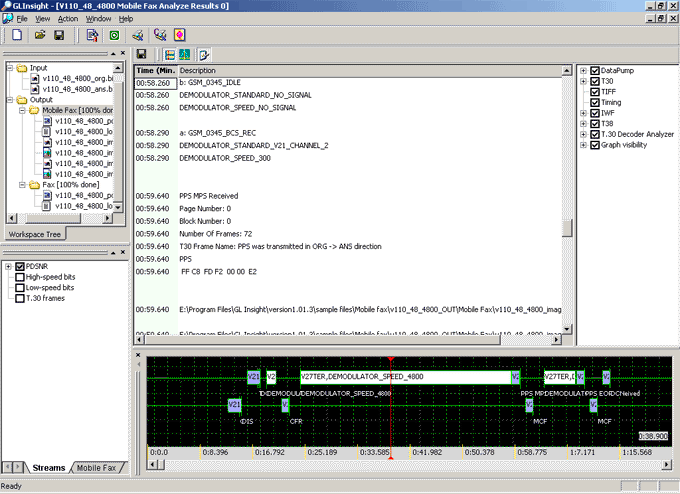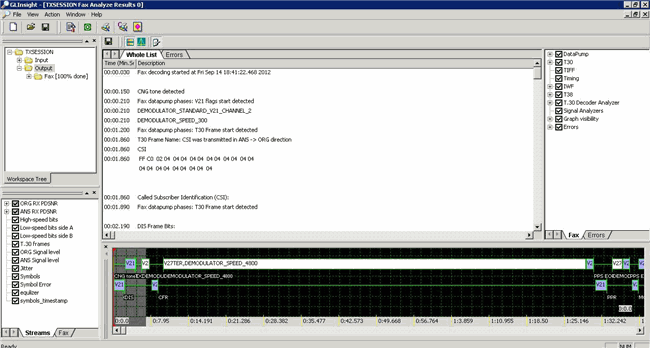GLInsight™: An Expert System for Decoding and Analysis of Fax and Modem Communications Over PSTN or IP Networks
GL Insight™ enables decoding and analysis of pre-recorded modem and fax transmissions. The transmission signals can be recorded from PSTN or IP media. It is a unique system used by developers of modem and fax technology often in interoperability labs.
Request a Demo / Quote BrochureOverview
GL Insight™ enables decoding and analysis of pre-recorded modem and fax transmissions. The transmission signals can be recorded from PSTN or IP media. It is a unique system used by developers of modem and fax technology often in interoperability labs. GL Insight™ can be used during the development and deployment phases of the products that support fax and modem transmission.
GL Insight™ receives the recorded modem or fax transmissions in one of the two ways:
- As raw signal files (PCM files) - in either mono or stereo format
- As IP capture files - created by capturing devices or by software
GLInsight™ demodulates the raw transmissions and presents the decoded data in an easy to understand format. It produces extensive log files with all relevant debugging information for easy event tracing which in turn provides insight to potential sources of problems.
GL's tools for Fax and Modem Call Capture
Over PSTN - The raw files required for fax and modem analysis in the case of PSTN (2-wire or TDM) can be obtained using following hardware platforms:
- GL's T1 E1 Analyzer with Call Capture Analysis (CCA) - The capability of CCA software to non-intrusively record calls directly from T1 E1 lines offers a solution to capture Voice/ Fax / Modem traffic from the 2-wire Analog interface. However, this capture solution requires the purchase of T1 E1 Analyzer.
- GL's 2-Wire Voice Recorder with Dual UTA HD - The Voice Recorder Software is primarily used in conjunction with Dual UTA HD (High Density) hardware device to capture the voice/modem/fax data manually / automatically from the 2-wire Analog interface.
The recorded PCM voice/data files can be analyzed using GL Insight™ Modem and Fax Analysis Software for 2-wire Analog interface and Adobe Audition (third-party application) for voice files analysis.
Over IP - Similarly, for fax and modem analysis over IP, the captured files can be obtained using GL's PacketScan™ - VoIP analyzer.
- GL's PacketScan™ - PacketScan™ software supports capturing and decoding of Fax (T.38 data) calls over VoIP. PacketScan™ fax decodes can be viewed in the form of T.38 call graph and call summary with decoded information for all T.38 messages received on the call. The captured fax calls by PacketScan™ can also be analyzed using GLInsight™ by saving the fax calls directly in (*.PCAP) Ethereal file format
Who Benefits from GLInsight™?
Equipment Developers (Gateways, RAS, Fax Servers, etc.)
- Provides bottom-up deep diagnosis of the call
e.g. (fax): provide info from data pump layer up to tiff picture - Helps solve interoperability issues
- Diagnoses physical layer problems
- Diagnoses network layer problems
Service Providers (Mobile Operators, ISPs, WISPs, Carriers & Operators)
- Non-intrusive IP network diagnosis
- High packet loss rate
- High jitter
- Non-intrusive TDM network diagnosis
- Echo path
- Echo canceller performance
- Indicates possible location of problems
Main Features
- Enables demodulation and analysis of Data (Modem), Fax, Mobile Fax, Mobile Data, and VoIP transmissions over TDM and IP networks
- Offline analysis of TDM & IP captured files
- Mixed Fax-over-IP using T.38/G.711 and Fax-over-PSTN Cross Analysis
- Mixed Modem over IP (Using G.711) and Modem over PSTN Cross Analysis
- Time synchronization performed on PSTN and IP signals
- Cross analysis of two networks
- Provides bottom-up deep diagnosis of calls to solve interoperability issues
- Diagnoses physical and network layer problems
- Non-intrusive IP/TDM network diagnosis of high packet loss rate, high jitter, echo path, and echo canceller performance, to indicate possible locations of problems
- Supported on Windows OS (7 / 8.1 / 10 PRO - 32-bit and 64-bit)
Analyzing T.38 Communications (Fax over IP)
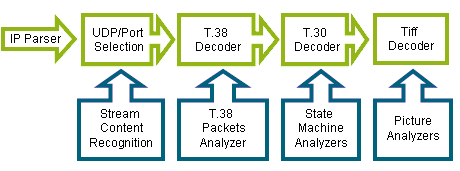
Analyzers:
| IP Stream | |
|
|
| T.30 Decoder | |
|
|
Analyzing Fax Communications over PSTN and IP (using G.711)
Analyzers:
| IP Stream | |
|
|
| Data Pump State Machine | |
|
|
| Signal | |
|
|
| T.30 Decoder | |
|
|
Analyzing Modem Communications over PSTN and IP (using G.711)
Analyzers:
| IP Stream | |
|
|
| Data Pump State Machine | |
|
|
| Signal | |
|
|
| Error Correction Data Compression | |
|
|
Cross-Analysis of Two Networks
Detailed GLInsight™ Capabilities
| Fax-Over-IP using T.38 Decoding and Analysis | |
|
|
| Fax-over-IP (using G.711) Decoding and Analysis | |
| IP Analysis Information | |
|
|
| Fax Analysis Information | |
Supported Protocols
|
|
Fax Decoding Categories & Sub-categories
|
|
| Fax-over-PSTN Decoding and Analysis | |
Supported Protocols
|
|
Fax Decoding Categories & Sub-categories
|
|
| Modem over IP Decoding and Analysis | |
Supported Protocols
|
|
Supported Start-up Protocols
|
|
Supported Error Correction & Data Compression Protocols
|
|
| Modem Decoding-and-Analysis Information Categories & Sub-categories
|
|
| Modem over PSTN Decoding and Analysis | |
Modem Analysis Information
Categories & Sub-categories
|
| Cross Analysis Decoding Schemes | ||
| Identically Coded and Analyzed Info Categories | ||
|
||
| Uniform Decoding & Analysis Schemes | ||
|
||
GLInsight™ Frequently Asked Questions
- What is GLInsight™?
GLInsight™ is GUI based fax and modem data analysing software, it uses pre-recorded fax transmissions to analyze and predict the quality of the calls.
- What platforms does GLInsight™ run on and what kind of hardware do I need?
- PC Requirements Windows® 7 / 8.1 / 10 PRO (64 bit).
- Currently GLInsight™ doesn’t supported on Windows® 10 Enterprise edition
- Minimum CPU Requirements - Core i3 or Higher with 4 GB RAM, USB 2.0 Ports.
- HASP-GLInsight™ Protection Plug
- Can I run 32-bit GLInsight™ on a 64-bit computer?
-
GLInsight™ 32-bit versions will work on 64-bit machines. But it is advised to use 64-bit versions when high performance is desired.
- Can I run 64-bit GLInsight™ on a 32-bit computer?
-
GLInsight™ 64-bit application is designed for the 64-bit version of Windows® will not work on the 32-bit version.
- What protocols are currently being supported in GLInsight™?
GL Insight Supports the following protocols:
- Start-up protocols V.8, V.8bis, and V.8 short are supported.
- T4/T6, T.30, T.38 Fax protocols
- Modulations V.92, V.90, V.34, V.32bis/V.32, V22bis/V.22, V.21, V.23, and Bell 103/ Bell 212 are supported.
- V.42, V.42bis, V.44, MNP2-4, MNP5, and V.14 are the supported error correction and data compression protocols.
- Can GLInsight™ analyze Fax data from IP network?
- Yes, it can analyze fax data recorded from IP and PSTN, it supports decoding of fax from PCM files with data written to them in flowing formats: a-law, ulaw or linear16 bit PCM and it can also analyze PCAP files
- Which all modem data GLInsight™ can decode and analyse?
- It can analyze data generated by following modems v.8, v.21, v.21ter, v.22, v.27, V.29, V.17, v.32, v.32bis, V.34 (half duplex or duplex mode), v.90, v.92
- Can GLInsight™ be executed remotely?
-
No
- Which Fax protocols can GLInsight™ analyse?
Fax protocols: T.30, T.38, T.4, T.6
Modem protocols: v.8, v.21, v.22, v.27, V.29, V.17, v.32, v.32bis, V.34 (half duplex or duplex mode), v.90, v.92- Can GLInsight™ provide information on fault in Fax flow over multiple networks?
- Yes, it has a mode of operation called as cross mode which can be used to get information on the fault.
- What is the nature of decoding/analysis in GLInsight™?
- It decodes the fax/modem messages and logs the modem and fax data to separate text files, it also displays these events on a graph in order of occurrence, it also does a post detection signal to noise ratio on modem data which is actually an indication of transmission/reception quality and it extracts the tiff image which was transmitted
- Can GLInsight™ run independently and do bulk Fax calls analysis without human intervention?
- No
- Can GLInsight™ support automated real-time monitoring?
- No
GLInsight™ Screenshots
Resources
Note: PCs which include GL hardware/software require Intel or AMD processors for compliance.
Please Note: The XX in the Item No. refers to the hardware platform, listed at the bottom of the Buyer's Guide, which the software will be running on. Therefore, XX can either be ETA or EEA (Octal/Quad Boards), PTA or PEA (tProbe Units), XUT or XUE (Dual PCIe Express) depending upon the hardware.
* Specifications are subject to change without notice.
